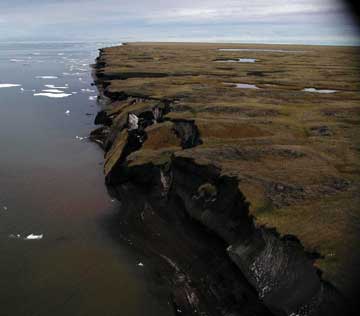|
NEWS NOTES
Geomorphology
Alaska melting into the sea
 Gary Clow, USGS |
| Alaska’s northern coastline, such as at Drew Point, pictured here, is slipping into the sea as waves undercut the permafrost cliffs and cause block slumping (as seen in the center of the photo). |
Northern Alaska is crumbling into the sea, according to newly released satellite images that show how rising global temperatures appear to be rapidly transforming the polar landscape.
Researchers studying the low-lying land north of Teshekpuk Lake in the National Petroleum Reserve in Alaska (NPRA) have long known that erosion rates along Alaska’s northern coastal plain are higher than elsewhere in the world, says John C. Mars, a remote sensing specialist for the U.S. Geological Survey (USGS) Mineral Resources Program in Reston, Va. “We knew from previous research that [erosion] rates between 1955 and 1985 were among the highest in North America — about half a square kilometer lost per year,” Mars says. Now, by comparing new images taken since 1985 against topographic maps from 1955, Mars and his team have calculated coastal erosion rates over the last half-century.
“What is surprising is that since 1985, coastal erosion rates have more than doubled,” Mars says. Reporting in the July Geology, his team found that along 130 kilometers of coastline in their study area, land is eroding at a rate of 1.08 square kilometers per year — thus losing an area about the size of 200 football fields each year.
Several factors contributed to this increase, Mars says. Melted ice caps no longer shield the ocean surface from prevailing winds, leading to choppier waters that undercut the soft cliffs prevalent along Alaska’s northern shore, he explains. Furthermore, many of the numerous shallow lakes that dot the landscape are expanding as permafrost melts, sometimes breaching the coastline and creating bays or open water. “We think all of this is due to climate change — more extensive melting of summer ice pack means less protection of the coastline, hotter temperatures mean rapidly melting permafrost,” he says, adding that additional study is needed to firmly establish the exact role of these contributions to coastal erosion.
The consequences of this erosion are manifold. Drilling sites on the NPRA, which according to USGS could yield more than 9.3 billion barrels of oil and roughly the same volume of natural gas, would need to be established with extreme care in order to withstand the physical effects of receding shorelines and expanding lakes, Mars says.
In addition, conservation ecologists worry about how the region, which hosts several endangered and threatened waterfowl species and large herds of caribou, will react to coastline loss and the freshwater lakes breaching into the ocean. “There will likely be profound changes in the intertidal food web that these animals depend on,” says Steve Zack, a biologist with the Wildlife Conservation Society in Portland, Ore. “Habitats will also be threatened as lakes drain into the sea and freshwater marshes disappear.”
Then of course there is the concern that eroding tundra and melting permafrost may release carbon dioxide and methane — potent greenhouse gases currently trapped in the permafrost — back into the atmosphere, Mars adds.
In light of the recent study, USGS is mounting a more extensive survey of the northern Alaskan coast to examine variations in the structure and composition of the shoreline, says John Haines, program coordinator for the USGS Coastal and Marine Geology Program in Reston, Va. “Rates of coastal erosion in this region are clearly phenomenal and we need to conduct further studies not only to improve our national coastal assessments, but to begin forecasting what the region will look like in the future,” given that there’s very little if anything that can be done to halt the erosion, he says. Preliminary work on this survey is currently under way.

 Subscribe
Subscribe


